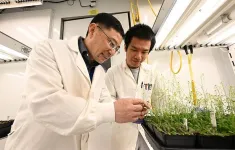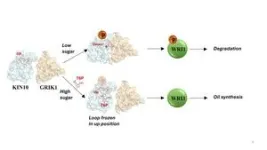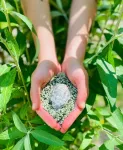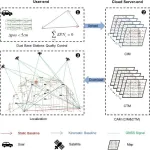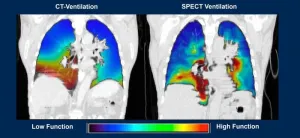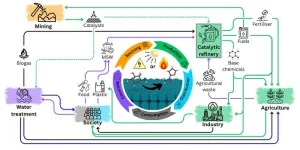(Press-News.org) UPTON, N.Y. — Scientists from the U.S. Department of Energy’s (DOE) Brookhaven National Laboratory have discovered that a protein responsible for the synthesis of a key plant material evolved much earlier than suspected. This new research explored the origin and evolution of the biochemical machinery that builds lignin, a structural component of plant cell walls with significant impacts on the clean energy industry.
When the first land plants emerged from aquatic environments, they needed to adapt in order to survive.
Chang-Jun Liu, a senior scientist in Brookhaven’s Biology Department, said, “The emergence of lignin, which provides structural support for the plants, was a key evolutionary event that enabled plant survival in the new terrestrial environment.”
Understanding how plants developed protective mechanisms that enable survival in new environments is vital as they face challenges imposed by climate change today. But lignin is also of great interest to researchers searching for clean energy options. This tough plant material can be processed and converted into valuable bioproducts. And lignin is the only renewable source of aromatic compounds, which are chemically similar to molecules found in conventional jet fuel and can be used as “drop-in” fuel by airlines.
“Modern plants contain three types of lignin, but most early lignin-containing plants had only two types. The ‘newer’ lignin is called syringyl-lignin, or S-lignin,” explained Liu. S-lignin evolved relatively recently with flowering plants and is structurally less complex than the other lignin components. Its potential industrial applications, in particular, have captured the attention of scientists because S-lignin is relatively easy to break down to simple aromatics.
The new study, recently published in The Plant Cell, builds on years of research focused on lignin and the molecules responsible for its synthesis. In 2019, Liu and his colleagues discovered that a specific cytochrome b5 protein, CB5D, is indispensable for the production of S-lignin but not the other, more ancient types of lignin.
“The uniqueness of CB5D’s role in S-lignin synthesis intrigued us,” Liu noted. “So, we were inspired to further explore its origin and evolution.”
Enzymatic teamwork
In a previous study, Liu’s team found that CB5D has a special partnership with an enzyme called ferulate 5-hydroxylase (F5H). Together, these molecules synthesized the valuable S-lignin.
The scientists knew that the evolution of F5H in flowering plants had led to the production of S-lignin. So, they expected to find that CB5D had co-evolved with F5H.
To explore their hypothesis, the scientists ran a genetic analysis to find other plant species whose DNA contained genes similar to the modern CB5D gene, which acts as instructions for assembling the CB5D protein. They identified 21 species, ranging from evolutionarily ancient to evolutionarily recent. The scientists then synthesized these genes and individually expressed them in a modern plant species that was genetically altered to lack the CB5D gene.
“Without the CB5D gene, the plant synthesizes only a small amount of S-lignin,” said Xianhai Zhao, a postdoctoral researcher at Brookhaven and lead author on the new paper. “But if this function was restored with the expression of one of the related genes, then we would know that gene functions similarly to the modern CB5D gene.”
The scientists discovered that a gene from a green algae species that evolved into an early land plant over 500 million years ago restored S-lignin synthesis in the modern plant. This indicated that the gene exhibited CB5D-type functionality. The scientists also found that the function was conserved in several early land plants, like liverworts and mosses.
“This means that the CB5D evolved millions of years earlier than we had expected,” explained Liu. “It was quite surprising to find that a modern electron acceptor like F5H had partnered with an ancient protein to develop new biochemical machinery that synthesizes the advanced lignin structure.”
Scientific teamwork and next steps
The CB5D gene and its more ancient counterpart contained similar DNA sequences and functions. But the scientists wanted to make sure that the CB5D protein from an ancient species, like liverwort, was expressed in the same subcellular structures as modern CB5D.
So, they used confocal microscopy at the Center for Functional Nanomaterials, a DOE Office of Science user facility at Brookhaven Lab, to confirm that this was the case.
Having found ancient genes that encode proteins similar to the modern CB5D protein in terms of S-lignin synthesis in modern plants and cellular localization, the team wanted to learn more about this protein’s ancient function and how it changed or expanded over time.
Their analysis showed the CB5D-like protein emerged in aquatic algae just before they transitioned to a terrestrial environment. And because it was conserved in early land plants, this protein likely serves one or more essential functions.
“Ancient plants like liverwort didn’t contain S-lignin,” said Zhao. “If the CB5D-type protein wasn’t responsible for synthesizing S-lignin, what did it do?”
Liu remarked, “That’s the beauty of research. Answering one question leads you to even more interesting questions waiting to be explored.”
This work was supported by the DOE Office of Science.
Brookhaven National Laboratory is supported by the Office of Science of the U.S. Department of Energy. The Office of Science is the single largest supporter of basic research in the physical sciences in the United States and is working to address some of the most pressing challenges of our time. For more information, visit science.energy.gov.
Follow @BrookhavenLab on social media. Find us on Instagram, LinkedIn, X, and Facebook.
Related Links
Scientific paper: “Cytochrome b5 diversity in green lineages preceded the evolution of syringyl lignin biosynthesis”
Unlocking Sugar to Generate Biofuels and Bioproducts END
Modern plant enzyme partners with surprisingly ancient protein
Study reveals that protein responsible for building a key component of modern plant cell walls first emerged in ancient species
2024-05-17
ELSE PRESS RELEASES FROM THIS DATE:
Ion irradiation offers promise for 2D material probing
2024-05-17
Two-dimensional materials such as graphene promise to form the basis of incredibly small and fast technologies, but this requires a detailed understanding of their electronic properties. New research demonstrates that fast electronic processes can be probed by irradiating the materials with ions first.
A collaboration involving researchers at the University of Illinois Urbana-Champaign and the University of Duisburg-Essen has shown that when graphene is irradiated with ions, or electrically charged atoms, the electrons that are ejected ...
Scientists develop new geochemical ‘fingerprint’ to trace contaminants in fertilizer
2024-05-17
DURHAM N.C. – An international team of scientists has uncovered toxic metals in mineral phosphate fertilizers worldwide by using a new tool to identify the spread and impact of such contaminants on soil, water resources, and food supply.
“While mineral phosphate fertilizers are critical to boost global sustainable agriculture and food security, we found high levels of toxic metals in many fertilizers worldwide,” said Avner Vengosh, chair of the Earth and Climate Sciences division at Duke University’s Nicholas School of the Environment. “Our study developed a new method to identify sources and impacts of these metals on the environment.” Those ...
From the road to the cloud: leveraging vehicle GNSS raw data for spatial high-resolution atmospheric mapping and user positioning
2024-05-17
Innovative Global Navigation Satellite System (GNSS) positioning technologies harness massive vehicle-generated data to create high-resolution atmospheric delay correction maps, significantly enhancing Global Positioning System (GPS) accuracy across varied spatial scales. This new method exploits real-time, crowd-sourced vehicle GNSS raw data, refining traditional GPS applications and presenting a cost-effective solution for precise positioning.
The quest for enhanced Global Navigation Satellite System (GNSS) accuracy has been hindered ...
Study suggests that air pollution promotes inflammation in the brain, accelerating cognitive decline and increasing risk of dementia
2024-05-17
Results from new study suggests that long-term exposure to air pollution leads to increased risk in dementia in Denmark.
"We also find association with noise, but this seems to be explained by air pollution primarily. Our study is in line with growing international knowledge on this topic." says Professor at Section of Environmental Health Zorana Jovanovic Andersen.
This is an important finding which adds that air pollution, beyond well-known effects on respiratory and cardiovascular system, also has major impacts on our brain, promoting inflammation in the brain, accelerating cognitive decline, and increasing ...
New imaging software improves lung diagnosis for 30% of patients who can't tolerate contrast dye; has added diagnostic benefits for all patients
2024-05-17
Southfield, Mich., May 17, 2024 – For up to 30% of patients who are allergic to medical contrast dye or have a dye restriction because of other health conditions, they might find that it takes longer to get a diagnosis when it comes to life-threatening lung issues such as pulmonary embolism. That's because imaging methods that detect lung problems but don't use contrast dye aren't as accurate and can be more time-consuming to administer.
Now, new imaging software, developed by pulmonologist Girish Nair, M.D., with Corewell Health William Beaumont University Hospital in Royal Oak, Michigan, and biomedical ...
A trial HIV vaccine triggered elusive and essential antibodies in humans
2024-05-17
DURHAM, N.C. – An HIV vaccine candidate developed at the Duke Human Vaccine Institute triggered low levels of an elusive type of broadly neutralizing HIV antibodies among a small group of people enrolled in a 2019 clinical trial.
The finding, reported May 17 in the journal Cell, not only provides proof that a vaccine can elicit these antibodies to fight diverse strains of HIV, but that it can also initiate the process within weeks, setting in motion an essential immune response.
The vaccine candidate targets an area on the HIV-1 outer envelope called the membrane proximal external region (MPER), which ...
Can we revolutionise the chemical industry and create a circular economy? Yes, with the help of catalysts
2024-05-17
The chemical industry is a cornerstone of global development, driving innovation, and providing essential products that support our modern way of life.
However, its reliance on unsustainable fossil resources has posed significant threats to global ecosystems through climate change and chemical pollution.
A new commentary published in Cell Press’ OneEarth co-authored by Griffith University researchers puts forth a transformative solution: catalysis to leverage sustainable waste resources, ushering the industry from a linear to a circular economy.
“If ...
Rutgers researchers identify impacts of Russia-Ukraine war on hospitals
2024-05-17
Rutgers researchers, aided by international collaborators, have tracked the devastation war has made on Ukraine’s hospital system.
Hundreds of hospitals in Ukraine have been forced to close or operate at a reduced capacity since Russia’s invasion of the Eastern European country in February 2022. Damage, destruction and supply shortages caused by the war have impaired the nation’s hospital system and taken a serious toll on human health.
In a study published in JAMA, Rutgers researchers and collaborators from the United States, Pakistan and Ukraine collected and compared data on hospital services provided both during ...
Differing values of nature can still lead to joined up goals for sustainability
2024-05-17
Recognising and respecting the different ways nature is valued can enable better environmental decision-making, according to new research led by the University of East Anglia (UEA).
International agreements such as the Sustainable Development Goals represent wide support for a sustainable future, living within planetary boundaries and ensuring a safer future for current and next generations.
However, there remain huge disagreements about how to advance such goals, often resulting in marginalisation, conflict and inaction.
The paper, published in the journal One Earth, ...
Ultraprocessed food consumption and cardiometabolic risk factors in children
2024-05-17
About The Study: The findings of this study suggest that high ultraprocessed food (UPF) consumption in young children is associated with adiposity and other cardiometabolic risk factors, highlighting the need for public health initiatives to promote the replacement of UPFs with unprocessed or minimally processed foods.
Corresponding Author: To contact the corresponding author, Nancy Babio, Ph.D., email nancy.babio@urv.cat.
To access the embargoed study: Visit our For The Media website at this link https://media.jamanetwork.com/
(doi:10.1001/jamanetworkopen.2024.11852)
Editor’s ...
LAST 30 PRESS RELEASES:
Eye for trouble: Automated counting for chromosome issues under the microscope
The vast majority of US rivers lack any protections from human activities, new research finds
Ultrasound-responsive in situ antigen "nanocatchers" open a new paradigm for personalized tumor immunotherapy
Environmental “superbugs” in our rivers and soils: new one health review warns of growing antimicrobial resistance crisis
Triple threat in greenhouse farming: how heavy metals, microplastics, and antibiotic resistance genes unite to challenge sustainable food production
Earthworms turn manure into a powerful tool against antibiotic resistance
AI turns water into an early warning network for hidden biological pollutants
Hidden hotspots on “green” plastics: biodegradable and conventional plastics shape very different antibiotic resistance risks in river microbiomes
Engineered biochar enzyme system clears toxic phenolic acids and restores pepper seed germination in continuous cropping soils
Retail therapy fail? Online shopping linked to stress, says study
How well-meaning allies can increase stress for marginalized people
Commercially viable biomanufacturing: designer yeast turns sugar into lucrative chemical 3-HP
Control valve discovered in gut’s plumbing system
George Mason University leads phase 2 clinical trial for pill to help maintain weight loss after GLP-1s
Hop to it: research from Shedd Aquarium tracks conch movement to set new conservation guidance
Weight loss drugs and bariatric surgery improve the body’s fat ‘balance:’ study
The Age of Fishes began with mass death
TB harnesses part of immune defense system to cause infection
Important new source of oxidation in the atmosphere found
A tug-of-war explains a decades-old question about how bacteria swim
Strengthened immune defense against cancer
Engineering the development of the pancreas
The Journal of Nuclear Medicine ahead-of-print tip sheet: Jan. 9, 2026
Mount Sinai researchers help create largest immune cell atlas of bone marrow in multiple myeloma patients
Why it is so hard to get started on an unpleasant task: Scientists identify a “motivation brake”
Body composition changes after bariatric surgery or treatment with GLP-1 receptor agonists
Targeted regulation of abortion providers laws and pregnancies conceived through fertility treatment
Press registration is now open for the 2026 ACMG Annual Clinical Genetics Meeting
Understanding sex-based differences and the role of bone morphogenetic protein signaling in Alzheimer’s disease
Breakthrough in thin-film electrolytes pushes solid oxide fuel cells forward
[Press-News.org] Modern plant enzyme partners with surprisingly ancient proteinStudy reveals that protein responsible for building a key component of modern plant cell walls first emerged in ancient species
